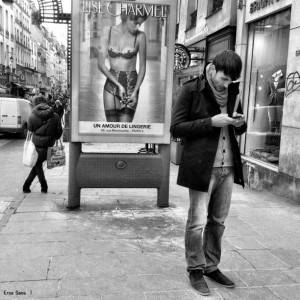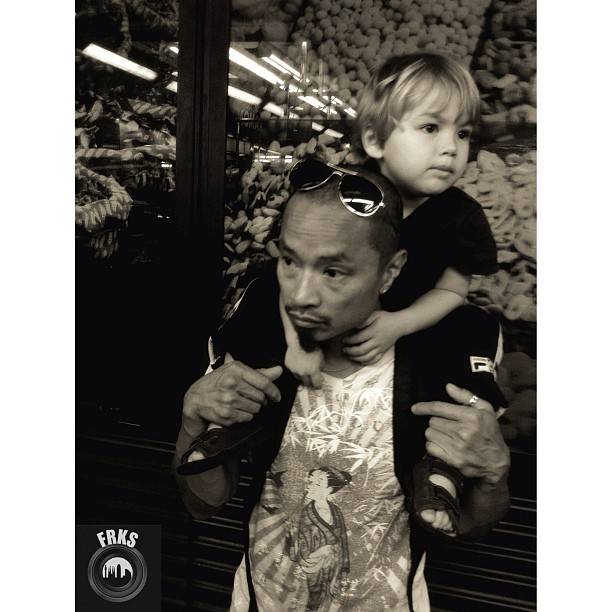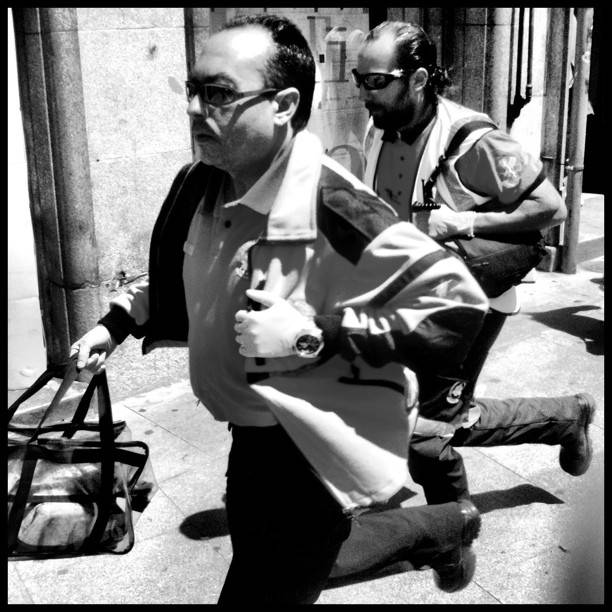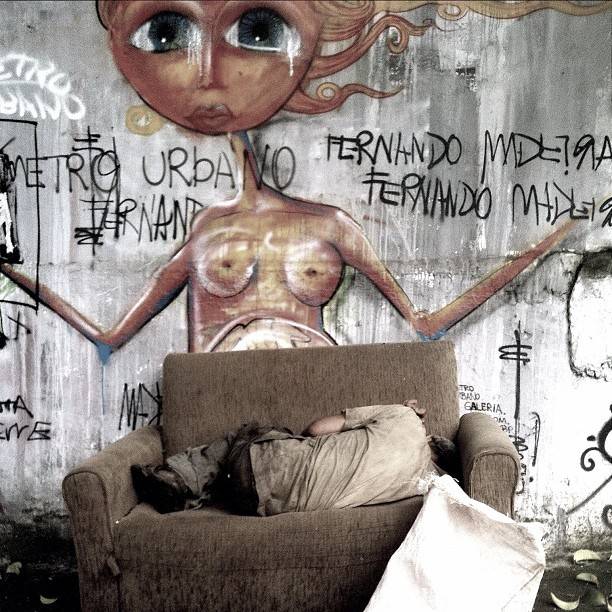Street photographers, “freezers” of moments which testify of our time
 “Photographers deal in things which are continually vanishing and, when they have vanished, there’s no contrivance on Earth which can make them come back again.” Henri Cartier-Bresson
“Photographers deal in things which are continually vanishing and, when they have vanished, there’s no contrivance on Earth which can make them come back again.” Henri Cartier-Bresson
.
Photograph our contemporaries is a way of testifying of our time. None of these moments will return, but each of them signs a period in the human adventure, a place, a moment in a life, in our lives. It’s our mark, Earthlings of the 21th century, our scene.
.
The french sociologist and philosopher Jean Baudrillard said : «Photography is our exorcism. Primitive society had its masks, bourgeois society its mirrors. We have our images.» In street photography, Cartier-Bresson, Maier, Depardon, Gökşin Sipahioğlu, to name only some of them, amaze by their technical exploits (light, framing, compo, momentariness, and so on).
But not only, so far. They knew how to print feelings in their film — loneliness, passion, despair, nonsense, tenderness, joke, etc. All the range of the human feelings which we still feel, more than a century later. Although the scene and the clothes changed. Let remind that the terms “street photography” includes all the pictures taken in the streets and in the other public places as the public transportation, which show unknown people. Who ignore most of the time that they’re the object of attention (the meaning of the word “candid”). (one of the hashtag used is usually #candid on Instagram )
.
What pleases us, in these old editions?
In a wink of eye, we dive into a past world as these witnesses seized it. With the first street photographers, we’re walking, wide open eyes, in the 20s. Brassaï shows us these Parisian villains, who defy us with their quietly ironic faces. In the 30s, we follow Capa in Madrid on ruins: a wall riddled with bullet holes in front of which play children is enough to report the state of the country. Then the cheeky kids of Doisneau in the post-war years, and “The Americans” of the 50s, who seem to roam without marks, in their two skin colors buses, through the objective of Robert Franck.
“If your pictures aren’t good enough, you’re not close enough.” Robert Capa.
.
The present street photography is nothing else than the heiress of these photographers called “humanists”.
We’re, too, witnesses of our respective cities.
We too watch living our contemporaries with tenderness always, with irony sometimes, with sadness on other times. It’s nothing but many testimonies of our time that the most talented of us will leave to the next generations. How lucky we are, with our cell phones, the street is easier because we can be discreet. Not to spy, not to laugh. But to report, while respecting the people.
All these characters frozen in time are us. Always a part of ourselves. I have never seen anything but tenderness in the lens of the iPhonographers I like. All these scenes are ours. Those in which we evolve every day. I guess that I love particularly the characters with whom I become identified. Diane Arbus confided that she shot “different” persons (handicaped, especially), because herself felt totally unsuitable for the society. Finally, she always staged herself, her feelings. The details which we notice suddenly, a glance, a coincidence, a particular brightness of light, this color, wouldn’t necessarily be seen by somebody else, even if he’s a photographer.
.
It’s moreover why, as in any art, what this one notices will not necessarily move that one.We don’t laugh at the same jokes, we don’t cry watching the same movies, why would we have to be “moved” (whatever is the emotion) by the same moments?
.
Be careful not to judge the photographers on IG: if you don’t like their photos, it doesn’t mean that they’re not “good”, it means simply that… you don’t like them! You’re not on the same wavelength. Maybe you’d have love it later. Maybe your subway’s neighbor would really love it — and it doesn’t mean he’s a jerk. The age, the knowledge, your state of mind of moment, and a ton of other parameters count. In the same way, if you follow somebody simply because he has a large number of followers, you get it all wrong: the number of followers says nothing about the sensibility of the person, nothing indicates that yours and his join. On the contrary, an IGer who had less than 100 followers isn’t inevitably crappy; simply he didn’t find yet his “public”. Maybe he’ll find it a month later or a century later. Making due allowances, never forget that Vincent van Gogh died without having found other public than his brother. That’s also why I’m always destabilized when people ask me who are the “best” photographers on IG.
When we’re lucky to find an IGer which shares our feelings, no mistake can be make: it’s either as if he’d your own glance or as if you finally discovered a world such as you anticipated it, dream about, or a forgotten universe. The impression’s so strong, you cannot miss it.
I still have my child’s soul, I recognize as a brother this character, shot by @SionFullana, photographer journalist, who seems to replay a “Singing In The Rain” scene, lonely in the street (yes, I really have already made that!). (see pic below)
I know well what feels this modern dad, tired but proud of his lil one, who counts on him, but also the enjoyment of this child, king of the world on these reassuring shoulders, @Freaksbcn (a collective of skilled Barcelona’s people, who also have each individual accounts). (see pic below)
Street photography doesn’t go systematically with monochrome pix. Of course, as the professional Giovanni Savino wrote me, our brain, accustomed to the work of the great period masters (early 20th century), who were limited by the technique, brings us to prefer spontaneously the black n white. It’s “classic”, as the Americans’ guys exclaim. Okay, but shoot passers-by in black n white isn’t enough! What of more unexceptional than passers-by? What more boring that an uniform stream which tells always the same story? In monochrome as in colors, imperatives remain: is the scene interesting? why? does she tells a story, even without the caption’s crutch? what does it mean? We go from laughter to tears, from tenderness to envy, and so on, in a few minutes. Our feelings are rich, our photos owe to be too.
I’m pretty sure that the expression of this man reflected some day in my face, while I was about to make a decisive and brilliant decision, and no matter the interpretation of @aliveinnyc in his caption: the feeling I can perceive here, in this scene, the way I appropriate it to admit it to my own feelings, that’s the point. It’s always a great pleasure to discover the others interpretations, sometimes different of the original meaning. And nobody’s true, nobody’s wrong. (see @aliveinnyc pic below)
I often feel the confusion of this man, powerless spectator of the stream of an hectic life, shot by @magneticart (this one is certainly apparently a camera’s pic, but this professional photographer also posts shots from his iPhone)… (see below)
Of course, I recognize the humor of @osqui as mine — always full of tenderness, often nonsense. I smile a lot by trailing round in streets, as he must do. His humor is, for me, his best strength. (see below)
In street photography, as in the other photographic domains, the light, the composition and the framing count (“A photo seen in its totality in one single moment, like a painting, its composition is a melting together, an organic coordination of visual elements.
You can’t compose gratuitously; there must be a necessity, and you can’t separate form from substance.” HCB.) These last two parameters allow the photo “to speak” without requiring of crutch caption (the most boring are those of the thirty-year old IGers, excited to join us to their philosophic thoughts about the meaning of life! Well, okay, guys, we’re all very proud of you!). The composition is the most difficult to make coincide with moment.
By definition, this one is at the same time fleeting and unstable — two constraints, time and movement, which ignore most of the other photographers. Let us remind that the composition (a term often badly used on IG) is what guides unconsciously the eye towards the real subject of the photo — forms and colors match to emphasize what we really want to show. That’s why nothing must be left at random. What Cartier-Bresson (sorry, but he spoke and wrote a lot) so formulated: «Take photographs means to recognize — simultaneously and within a fraction of a second — both the fact itself and the rigorous organization of visually perceived forms that give it meaning. It’s putting one’s head, one’s eye and one’s heart on the same axis.»
The highlight of a photography is to be enough explicit to require no text. Professional too (it’s not however a fate: photography can be learnt — moreover the evolution of most of our streams speaks about it), @BrooklynTheory, who doesn’t make only street pix, is a master on the subject. None of his photos needs a legend. And you’ll may scrutinize his images as I do for long minutes, you’ll find nothing gratuitous. Everything makes sense. Smart, he reserves his camera’s pix for his blog and posts only his iPhone pix on IG. I like getting absorbed into his universe, made by forms and by colors matching together. It’s sometimes funny or nonsense, often poetic (“Some photographs are like a Chekhov or a Maupassant short story. They’re a quick thing, and there’s a whole world in them. But one is unconscious of that while shooting. That’s a wonderful thing with a camera. It jumps out of you.” Henri Cartier-Bresson.) (see @brooklyntheory pic below)
.
“For me, photography is to place head, heart and eye along the same line of sight. (…) It’s a way of shouting, of freeing oneself, not of proving or asserting one’s own originality. It’s a way of life. Cartier-Bresson.
The street photo plays another role than retranscribe our timeless human feelings. It borders then with the photojournalism. A job which I know well because I work on photographers colleagues’ side for more than twenty years.
Of course, seing a paradisiac Rio or a nice San Francisco, those of the postcards, is really good. But we want to see everything. The son of the Spanish photographer Ramón Masats, who posts incognito on IG, said me that “by showing only the attractive side of our streets, we create an artificial paradise, a decoy of the despair of the whole world”. Because, nope, Paris isn’t what you see in the Hollywood movies. Not far from the Eiffel Tower, people dies, more and more each year, in the cold streets of the “city of love”, in the nation of the Human Rights.
The world crisis of the media brings press barons to make financial choices. The professional witnesses whom are the journalists aren’t sent any more to the theater of streets — there’s no financial interest there (and we’re for nothing there: most of us would like to make our job, to report, to denounce, to give the floor!). And so the Arab Spring took its vigour in the social medias. And so “los Indignados” (“indignant people”) became known beyond the Spanish borders. In May, 2011, we discovered a rebel Madrid (for example, with this pic of @slimjazz):
At the moment, only Instagram reported it. By posting the information on Twitter and Facebook, we eventually interested my colleagues of the international departments.
The same phenomenon occur in September, when New Yorkers followed the Spaniards, with Occupy Wall Street. IG informed early about this movement (widely supported by The Anonymous, as we could see on many pix), who quickly propagated in the other American cities. The media relieved the information only one month later (in France). Again, the media were informed via Twitter and FB, among others thanks to this pic of our colleague @richnyc:
Some war photographers work now with their cell phone — the advantage of the discretion is undeniable, the journalists being rarely welcome. So, Balazs Gardi covered Afghanistan with his iPhone.
During the Indignados’ movement, Sergio in Madrid, aka @_ser, created his famous tag, sad & brilliant, which made, since, a world tour: #TheInvisibles. His idea: show how the poverty is goes alongside to the ordinary life of the workers who run all day long, without giving attention on the held out hands. Impressive pix were published under this tag since (regrettably, without giving systematically a shout to its creator). The very first, by @_ser, was this one:
A last thing? Shot, shot, shot, you’ll choice later which scene means something to you. And indulge yourselves, express yourselves freely: no other constraint. If, one day, I hope you’ll do, you expose in a gallery, it’ll be high time to group your pix to form themes.
Note: I name here only a few of street photographers on Instagram, cuz it wasn’t possible to name all of those I like, please forgive me.
We want to thanks @clok_moitie for this great article and contribution in our Instagramers website. Looking forward more contributions from her.
More streetphotographers here below and in our FocusOn section.
@eros_sana, France
@nikil_xia from China
@shutdagizm from Indonesia


















